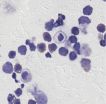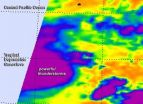(Press-News.org) Spider silk is an impressive material; lightweight and stretchy yet stronger than steel. But the challenge that spiders face to produce this substance is even more formidable. Silk proteins, called spidroins, must convert from a soluble form to solid fibers at ambient temperatures, with water as a solvent, and at high speed. How do spiders achieve this astounding feat? In new research publishing in the open access journal PLOS Biology on August 5, Anna Rising and Jan Johansson show how the silk formation process is regulated. The work was done at the Swedish University of Agricultural Sciences (SLU) and Karolinska Institutet in collaboration with colleagues in Latvia, China and USA.
Spidroins are big proteins of up to 3,500 amino acids that contain mostly repetitive sequences, but the most important bits for the conversion of spidroins into silk are the ends. These terminal regions of the proteins are unique to spider silk and are very similar between different spiders. Spidroins have a helical and unordered structure when stored as soluble proteins in silk glands, but when converted to silk their structure changes completely to one that confers a high degree of mechanical stability. These changes are triggered by an acidity (pH) gradient present between one end of the spider silk gland and the other. The gland proceeds from a narrow tail to a sac to a slender duct, and it is known that silk forms at a precise site within the duct. However, further details of spider silk production have been elusive.
By using highly selective microelectrodes to measure the pH within the glands, the authors showed the pH falls from a neutral pH of 7.6 to an acidic pH of 5.7 between the beginning of the tail and half-way down the duct, and that the pH gradient was much steeper than previously thought. The microelectrodes also showed that the concentration of bicarbonate ions and pressure of carbon dioxide simultaneously rise along the gland. Taken together, these patterns suggested that the pH gradient might form through the action of an enzyme called carbonic anhydrase, which converts carbon dioxide and water to bicarbonate and hydrogen ions (and thereby creating an acidic environment). Using a method developed by the authors, they were able to identify active carbonic anhydrase in the narrower part of the gland and confirm that carbonic anhydrase is indeed responsible for generating the pH gradient.
The authors also found that pH had opposite effects on the stability of the two regions at each end of the spidroin proteins, which was surprising given that these regions had been suggested to have similar roles in silk formation. While one of the ends (the "N-terminal domain") tended to pair up with other molecules at the beginning of the duct and became increasingly stable as the acidity increased along the duct, the other end (the "C-terminal domain") destabilized as the acidity increased, and gradually unfolded until it formed the structure characteristic of silk at the acidic pH of 5.5. These findings show that both ends of the protein undergo dramatic structural changes at the pH found at the beginning of the duct, which is also the point where carbonic anhydrase activity is concentrated.
These insights led the authors to propose a new "lock and trigger" model for spider silk formation, in which gradual pairing up of the N-terminal domains locks spidroins into a network of many protein molecules, while the changes of structure in the C-terminal domains could trigger the rapid polymerization of spidroins into fibers. Interestingly, the structure of the C-terminal domain is similar to those in the "amyloid" fibrils found in the brains of individuals with diseases such as Alzheimer's disease. This mechanism elegantly explains how spider silk can form so quickly and smoothly within the spinning duct of these amazing animals. Besides helping humans to understand how they might mimic the spiders to produce biomimetic spidroin fibers for our own purposes, knowing how spiders spin silk could give insights into natural ways of hindering the amyloid fibrils associated with diseases like dementia.
INFORMATION:
Please mention PLOS Biology as the source for this article and include the links below in your coverage to take readers to the online, open access articles
All works published in PLOS Biology are open access, which means that everything is immediately and freely available. Use this URL in your coverage to provide readers access to the paper upon publication:
http://www.plosbiology.org/article/info:doi/10.1371/journal.pbio.1001921
Contact:
Dr Rebecca Caygill
Media Relations Manager
Life sciences, engineering, maths & physical sciences & the built environment
UCL Communications & Marketing
Direct line: +44 (0)20 3108 3846
r.caygill@ucl.ac.uk | http://www.twitter.com/uclnews
http://www.ucl.ac.uk/media | http://www.ucl.ac.uk/news
Citation: Andersson M, Chen G, Otikovs M, Landreh M, Nordling K, et al. (2014) Carbonic Anhydrase Generates CO2 and H+ That Drive Spider Silk Formation Via Opposite Effects on the Terminal Domains. PLoS Biol 12(8): e1001921. doi:10.1371/journal.pbio.1001921
Funding: The Swedish Research Council. The funders had no role in study design, data collection and analysis, decision to publish, or preparation of the manuscript.
Competing Interests: The authors have declared that no competing interests exist
How spiders spin silk
2014-08-05
ELSE PRESS RELEASES FROM THIS DATE:
In search for Alzheimer's drug, a major STEP forward
2014-08-05
Researchers at Yale School of Medicine have discovered a new drug compound that may help reverse the cognitive deficits of Alzheimer's disease. Their findings are publishing on August 5 in the open access journal PLOS Biology.
The compound, TC-2153, inhibits the negative effects of a protein called STriatal-Enriched tyrosine Phosphatase (STEP), which is key to regulating learning and memory. These cognitive functions are impaired in Alzheimer's.
"Decreasing STEP levels reversed the effects of Alzheimer's disease in mice," said lead author Paul Lombroso, M.D., professor ...
Pyruvate oxidation is critical determinant of pancreatic islet number and β-cell mass
2014-08-05
Researchers at the University at Buffalo, led by Dr. Mulchand Patel and also at Lawson Health Research Institute and Western Ontario, London, Canada, led by Dr. David Hill, collaboratively evaluated the role of the mitochondrial multienzyme pyruvate dehydrogenase complex in the regulation of pancreatic β-cell development and maturation in the immediate postnatal period in mice. This study, reported in the August 2014 issue of Experimental Biology and Medicine, demonstrated that the pyruvate dehydrogenase complex is not only required for insulin gene expression and ...
Butterflies change wing color in new Yale research
2014-08-05
Yale University scientists have chosen the most fleeting of mediums for their groundbreaking work on biomimicry: They've changed the color of butterfly wings.
In so doing, they produced the first structural color change in an animal by influencing evolution. The discovery may have implications for physicists and engineers trying to use evolutionary principles in the design of new materials and devices.
The research appears this week in the journal Proceedings of the National Academy of Sciences.
"What we did was to imagine a new target color for the wings of a butterfly, ...
Seamless gene correction of beta-thalassemia mutations in patient-specific cells
2014-08-05
August 5, 2014 – A major hurdle in gene therapy is the efficient integration of a corrected gene into a patient's genome without mutating off-target sites. In a paper published today in Genome Research, scientists have used CRISPR/Cas genome editing technology to seamlessly and efficiently correct disease-causing mutations in cells from patients with β-thalassemia.
β-thalassemia results from inherited DNA mutations in the hemoglobin beta (HBB) gene, resulting in reduced HBB expression in red blood cells and, in the most severe forms, anemia. The only established ...
NASA sees Tropical Storm Julio as part of a heated Eastern Pacific
2014-08-05
The Eastern Pacific Ocean has been warm this springtime, and those warmer waters have contributed to the development of storms like Tropical Storm Julio and Hurricane Iselle.
"Ocean temperatures in the Eastern Tropical Pacific were heated up because of the strong Kelvin wave activity this spring. Although the initial excitement of an impending El Nino has quieted down, these warmer waters have caused an early and active hurricane season," said Bill Patzert, Climatologist at NASA's Jet Propulsion Laboratory in Pasadena, California.
"Kelvin waves" are massive ripples ...
Grizzly research offers surprising insights into diabetes-obesity link
2014-08-05
While diabetes rates are on the rise and are having serious effects on millions of people's health, researchers studying grizzly bears have now discovered a natural state of diabetes that serves a real biological purpose and is also reversible. Investigators reporting in the August 5 issue of the Cell Press journal Cell Metabolism note that grizzly bears are obese but not diabetic in the fall, become diabetic only weeks later in hibernation, and then somehow become "cured" of diabetes when they wake up in the spring. The research reveals how natural biology, through evolutionary ...
No apparent link between sleep apnea and cancer: Large study
2014-08-05
Obstructive sleep apnea, in which people stop breathing for short periods while sleeping, affects about 5% of Canadian adults aged 45 years or older and can negatively affect health. More than 1 in 5 adult Canadians have risk factors for sleep apnea such as being overweight, being male and having diabetes, chronic nasal congestion or other health conditions.
Studies have postulated that obstructive sleep apnea may be linked to cancer because of low levels of oxygen in the blood.
"There is a need for a sufficiently large cohort study with a long enough follow-up to allow ...
Common chemical in mothers may negatively affect the IQ of their unborn children
2014-08-05
(Boston) -- In some women abnormally high levels of a common and pervasive chemical may lead to adverse effects in their offspring. The study, published recently in the Journal of Clinical Endocrinology & Metabolism, is the first of its kind to shed light on the possible harmful side effects of perchlorate in mothers and their children.
Using data from the Controlled Antenatal Thyroid Study (CATS) cohort, researchers at Boston University School of Medicine (BUSM) and Cardiff University studied the effect of perchlorate, an environmental contaminant found in many foods ...
Story tips from the Department of Energy's Oak Ridge National Laboratory, August 2014
2014-08-05
To arrange for an interview with a researcher, please contact the Communications staff member identified at the end of each tip. For more information on ORNL and its research and development activities, please refer to one of our media contacts. If you have a general media-related question or comment, you can send it to news@ornl.gov.
MATERIALS – Transparent ballistic results …
Glass used for military vehicle windshields is being put to the test by an Oak Ridge National Laboratory team evaluating different formulations for mechanical strength, high pressure and shock ...
NASA sees bursts of thunderstorms in Tropical Depression Genevieve's center
2014-08-05
The AIRS instrument aboard NASA's Aqua satellite provided a look at what's happening under Tropical Depression Genevieve's clouds using infrared light, and it appears that thunderstorms are bubbling up again.
A false-colored infrared image created at NASA's Jet Propulsion Laboratory in Pasadena California used data from the Atmospheric Infrared Sounder (AIRS) instrument that flies aboard NASA's Aqua satellite. The AIRS data showed powerful thunderstorms re-developed around Genevieve's center on August 5 at 8:35 a.m. EDT. That's an indication that there's some punch left ...




